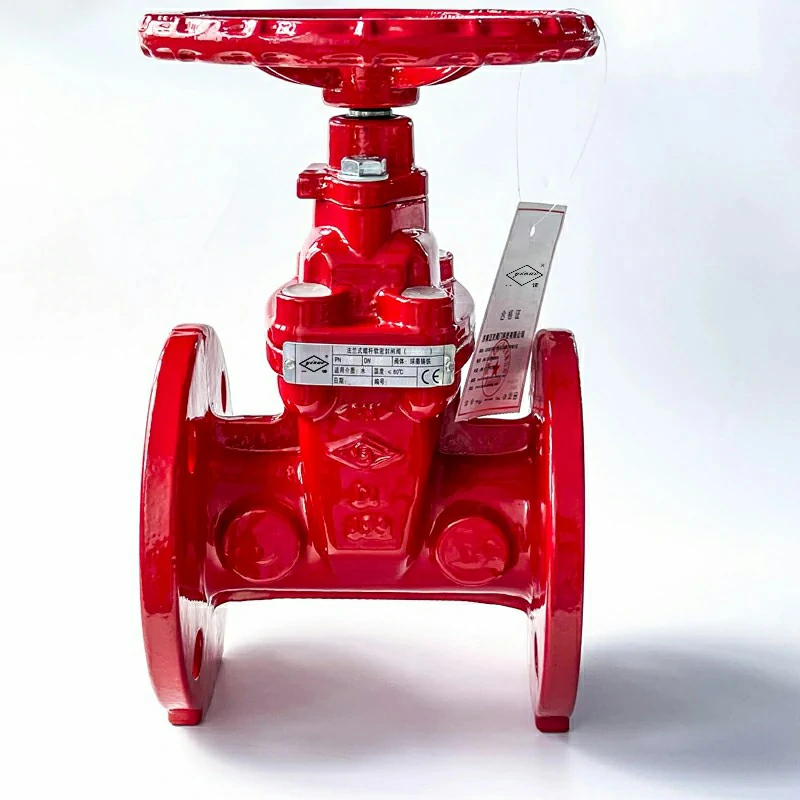Gate valves are essential components in various industries, providing control and regulation of fluid flow. Understanding the different types of gate valves and materials used in their construction is crucial forselecting the right valve for specific applications.
Types of Gate Valves:
- Rising Stem Gate Valve: in this type, the stem rises as the valve is opened, providing a visual indication of the valve position.
- Non-Rising Stem Gate Valve: The stem of this valve remains in a fixed position as the valve is operated, making it suitable for limited spaces.
- Solid Wedge Gate Valve: This type has a solid wedge design, offering excellent sealing properties but may be prone to sticking in high-temperature applications.
- Flexible Wedge Gate Valve: The wedge in this valve is made of two parts connected by a hinge allowing the valve to adapt to changes in temperature and pressure.
Materials Used:
- Ductile Iron: Ductile iron is a common material used in gate valves due to its strength, durability,and resistance to corrosion. Ductile iron valves are suitable for various applications, including water supply systems and wastewater treatment plants. for example: Ductile lron Valve.
- Stainless Steel: Stainless steel gate valves are preferred for applications requiring high corrosion resistance and strength. They are commonly used in chemical processing plants and oil refineries.
- Bronze: Bronze gate valves are ideal for marine applications and seawater systems due to their resistance to saltwater corrosion.
Size Used:
The size of a gate valve refers to the nominal diameter of the valve’s opening, which determines the flow capacity and compatibility with the pipeline system. Gate valves are available in a wide range of sizes to accommodate different flow rates and pipe diameters. Common gate valve sizes include:
- 1/2 inch Gate Valve: Ideal for residential plumbing systems and small-scale applications where precise flow control is required.
- 3/4 inch Gate Valve: A versatile option suitable for small-scale applications with limited space. lt provides precise flow control and shut-off capabilities.
- 1 inch Gate Valve: Suitable for moderate flow rates in residential, commercial, and light industrial settings.
- 2 inch Gate Valve: Commonly used in industrial applications with higher flow requirements and medium-sized pipelines.
- 4 inch Gate Valve: Designed for larger pipelines and industrial systems that require high flow rates and efficient fluid control. for example: 4 inch Slide Gate Valve.The 4 inch Slide Gate Valve is a versatile and efficient solution for managing fluid flow in industrial settings. lts size and design make it suitable for larger pipelines and applications that require high flow rates and precise control. The 4 Inch Slide Gate Valve provides excellent performance and reliability in handling substantial flow volumes, making it a valuable component in various industrial systems.
- 6 inch Gate Valve: Used in heavy-duty industrial applications where substantial flow capacity and durability are necessary.
- 8 inch Gate Valve: Typically found in large-scale industrial settings, water treatment plants, and municipal infrastructure for managing substantial flow volumes.
It is essential to select the appropriate size of the gate valve based on the flow requirements, operating conditions, and compatibility with the pipeline system to ensure optimal performance and efficiency.
Gate Valve Application Areas
Gate valves are commonly used in various industries and applications where efficient control of fluid flow is essential. Some common application areas of gate valves include:
- Water Supply Systems: Gate valves are widely utilized in water supply systems, including residential, commercial, and municipal infrastructure, for requlating water flow and controlling water distribution.
- Wastewater Treatment Plants: Gate valves play a crucial role in wastewater treatment plants for managing the flow of wastewater, controlling the movement of liquids, and isolating diferent sections of the treatment process.
- Oil and Gas Industry: Gate valves are essential components in the oil and gas industry for controlling the flow of oil, gas, and other fluids in pipelines, refineries, and drilling operations.
- Chemical Processing Plants: Gate valves are used in chemical processing plants to requlate the flow of chemicals, gases, and other substances within the production process, ensuring accurate control and safety.
- Power Generation Plants: Gate valves are employed in power generation plants, including thermal, nuclear, and hydroelectric facilities, to control the flow of steam, water, and other fluids in power generation processes.
- HVAC Systems: Gate valves are integrated into heating, ventilation, and air conditioning (HVAC)systems for controlling the flow of hot water, chilled water, and other fluids to maintain optimal indoor temperatures and environmental conditions.
- Marine and Shipbuilding Industry: Gate valves are utilized in marine applications, including ship building, offshore platforms, and marine vessels, for regulating the flow of seawater, ballast water, and other fluids in maritime operations.
- Mining and Minerals Processing: Gate valves are used in mining and minerals processing facilities to control the flow of flurries, lipids, and failings in mineral extraction, processing, and refining operations.
These are just a few examples of the diverse application areas where gate valves are essential components for fluid control and regulation in various industrial sectors.

In conclusion, gate valves play a vital role in regulating fluid flow in various industries. By understanding the different types of gate valves and materials used in their construction, engineers and operators can make informed decisions when selecting valves for specific applications.
